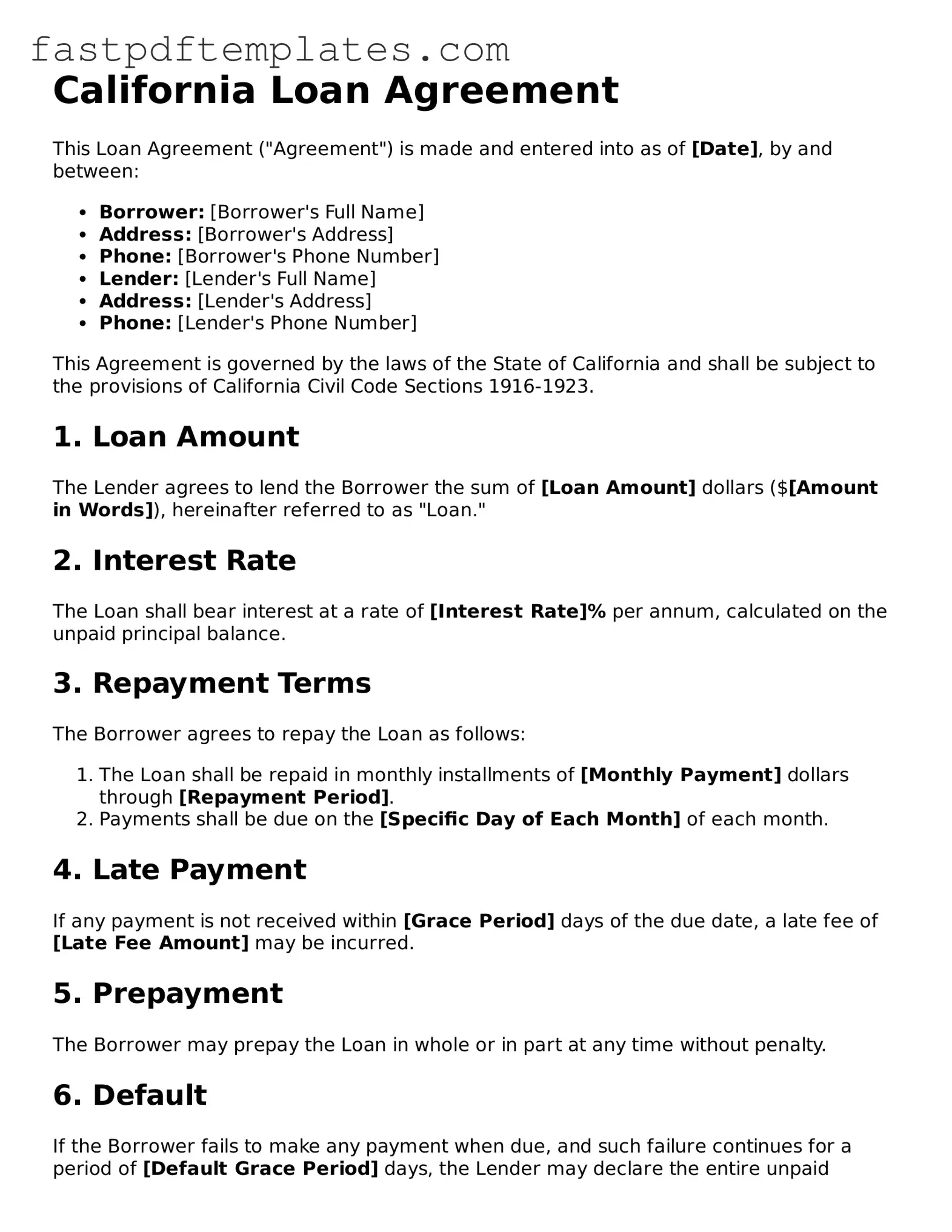The California Loan Agreement form bears similarities to the Promissory Note. A Promissory Note is a written promise to pay a specified amount of money to a designated party at a defined time or on demand. Like the Loan Agreement, it outlines the terms of repayment, including interest rates and payment schedules. Both documents serve as evidence of the debt and the borrower's commitment to repay it, making them crucial for lenders seeking to secure their financial interests.
Another document akin to the California Loan Agreement is the Mortgage Agreement. This document is used when real property serves as collateral for a loan. While the Loan Agreement focuses on the terms of the loan itself, the Mortgage Agreement details the rights and obligations of both parties regarding the property. Both agreements emphasize the borrower's promise to repay the loan, but the Mortgage Agreement adds a layer of security for the lender by establishing a legal claim to the property in case of default.
The Security Agreement is also comparable to the California Loan Agreement. This document is utilized when personal property is pledged as collateral for a loan. Like the Loan Agreement, it specifies the terms of the loan and the rights of the lender. However, the Security Agreement goes further by detailing the specific collateral involved and the procedures the lender may follow in the event of default. Both documents aim to protect the lender's interests while providing the borrower with access to funds.
The Installment Sale Agreement shares similarities with the California Loan Agreement, particularly in how it outlines payment terms. This document is used when a buyer purchases an asset through installment payments rather than a lump-sum payment. Like a Loan Agreement, it specifies the amount financed, the interest rate, and the payment schedule. Both documents create a structured repayment plan, ensuring that the seller receives payments over time while allowing the buyer to acquire the asset gradually.
The Lease Agreement also parallels the California Loan Agreement in certain contexts, especially when it involves a lease-to-own arrangement. In such cases, the Lease Agreement outlines the terms of renting a property with an option to purchase it later. Similar to a Loan Agreement, it includes payment terms and conditions. Both documents aim to establish a clear understanding of financial obligations between parties, facilitating transactions that involve gradual ownership transfer.
The Line of Credit Agreement is another document that resembles the California Loan Agreement. This agreement allows borrowers to access a specified amount of credit over time, similar to how a Loan Agreement provides a lump sum. Both documents outline repayment terms and interest rates. However, the Line of Credit Agreement offers more flexibility, allowing borrowers to withdraw funds as needed, while the Loan Agreement typically involves a fixed amount disbursed upfront.
The Personal Loan Agreement also shares characteristics with the California Loan Agreement. This document is used for loans between individuals rather than financial institutions. It includes essential terms such as the loan amount, interest rate, and repayment schedule, mirroring the structure of the Loan Agreement. Both documents serve to formalize the borrowing arrangement, ensuring that both parties are clear about their obligations and expectations.
The Business Loan Agreement is similar to the California Loan Agreement, particularly when financing is sought for business purposes. This document outlines the terms of the loan, including repayment schedules and interest rates, just like the Loan Agreement. However, the Business Loan Agreement often includes additional provisions related to business operations, such as covenants that require the borrower to maintain certain financial ratios or operational standards, adding complexity to the agreement.
Lastly, the Credit Agreement aligns with the California Loan Agreement in that it details the terms under which credit is extended to a borrower. This document is often used by financial institutions to outline the terms of a loan or line of credit. Like the Loan Agreement, it specifies the interest rate, repayment terms, and any fees associated with the borrowing. Both agreements aim to protect the lender's interests while providing the borrower with a clear understanding of their financial obligations.
